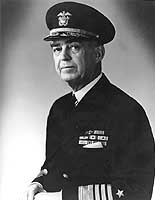The Pacific War Online Encyclopedia: Kinkaid, Thomas C. (original) (raw)
| ![]() The Pacific War Online Encyclopedia | |
| -------------------------------------------------------------------------------- | |
The Pacific War Online Encyclopedia | |
| -------------------------------------------------------------------------------- | |
Kinkaid, Thomas Cassin (1888-1972)

Naval Historical Center #84381
Thomas Kinkaid was born in New Hampshire and graduated from Annapolis in 1908. He sailed with the Great White Fleet aboard battleship Nebraska and continued to serve on battleships during most of his early career. An expert on ordnance, he graduated from the Naval Postgraduate School in 1913 and served as gunnery officer on Arizona during the First World War. He graduated from the Naval War College in 1930, commanded cruiser Indianapolis in 1937-1938, and served as naval attaché in Rome and Belgrade. He was in command of a destroyersquadron at the end of 1941.
Kinkaid was promoted to rear admiral and was present as prospective commanding officer with Fletcher's task force in the abortive Wake expedition. He was one of the few officers who defended Pye's decision to recall the expedition (Tuohy 2007):
I am extremely glad that Pye and Fletcher made what I consider to be sound decisions in those very difficult circumstances.... By their decisions they prevented the useless sacrifice of valuable ships which later was action with our enemy in circumstances of vital importance.
Kinkaid then took over Fletcher's cruiserdivision. When Nimitztook over Pacific Fleet, he assigned a second junior admiral to each of his carrier task forces to command its screen and lead any surface attack group that might be detached from the task force. Kinkaid was initially assigned to screen Leary's task force built aroundSaratoga. He was present at the battles ofCoral Sea, where he commanded the screen of the Lexington task force, and at and Midway, where he commanded Spruance's screen. He later defended Spruance's decision to turn east after nightfall.
Later that year, Kinkaid received command of Task Force 16 (Enterprise) in Halsey's absence, and he was present at the battle of the Eastern Solomons and in command at Santa Cruz. Following the Santa Cruz battle, he recommended that carriers should operate in pairs, a view that came to be widely shared. However, his decision to operate his aircraftout of Henderson Field to avoid attack on the Enterprisewas privately condemned by Halsey. Though he sugarcoated Kinkaid's subsequent relief sufficiently to preserve Kinkaid's career and reputation, the incident seems to have created bad blood between the two, which surfaced after the Battle of Leyte Gulf.
Kinkaid was given command of North Pacific Area on 4 January 1943 and directed the recapture of Attuand Kiska. He won the respect of Bucknerby moving his area headquarters to Adak, but clashed with Rockwell, who was senior and seemed to think he should be in command of joint landing forces. The problem was resolved by promoting Kinkaid to vice admiral in June 1943.
Kinkaid was moved to the Southwest Pacific in November 1943 to assume command of 7 Fleet, “MacArthur’sNavy”, where he served with distinction for the remainder of the war. Kinkaid has the distinction of having commanded more amphibious operations than any other commander in history.
Promoted to full admiral in April 1945, Kinkaid directed the landing of occupation forces in China and Korea. Postwar he commanded the Eastern Sea Frontier and the Atlantic Reserve Fleet before retiring in 1950.
A capable proponent of interservice cooperation and an excellent delegator, Kinkaid was also a genial man blessed with common sense and self-confidence. Though a ferocious chain smoker, he was cool under fire.
There isn't time to emote. There isn't time. A commanding officer may be scared — in fact, if he has any sense he's scared — but he can't show it, with all the men around.
In a postwar publication, Halsey tried to blame Kinkaid for the debacle off Samarduring the Battle of Leyte Gulf. Kinkaid kept a dignified public silence but privately was deeply hurt. Most senior naval officers sided with Kinkaid.
Service record
| 1888-4-3 | Born in Hanover, New Hampshire | |
|---|---|---|
| 1908-6 | Ensign | Graduates from Naval Academy, standing 136th in a class of 201. |
| 1913 | Naval Postgraduate School | |
| 1917 | Lieutenant | Pennsylvania |
| 1918 | Arizona | |
| 1919 | Bureau of Ordnance | |
| 1922 | Lieutenant commander | Vice chief of staff, U.S. Naval Detachment, Turkey |
| 1924 | Commander, DD Isherwood | |
| 1925 | Naval Gun Factory | |
| 1927 | Commander | Fleet Gunnery Officer, U.S. Fleet |
| 1929 | Naval War College | |
| 1930 | Secretary, General Board | |
| 1932 | Technical advisor at Geneva Disarmament Conference | |
| 1933 | Executive officer, Colorado | |
| 1934 | Officers' Detail Section, Bureau of Navigation | |
| 1937-1-1 | Captain | Commander, Indianapolis |
| 1938 | Naval attache, Italy and Yugoslavia | |
| 1941-6 | Commander, Destroyer Squadron 8 | |
| 1941-12-31 | Rear admiral | Commander, Cruiser Division 6 |
| 1942-10-29 | Commander, Cruisers, Pacific Fleet | |
| 1943-1-4 | Commander, North Pacific Area | |
| 1943-6-9 | Vice admiral | |
| 1943-11-26 | Commander, 7 Fleet | |
| 1945-4-3 | Admiral | |
| 1946-1 | Commander, Eastern Sea Frontier and Reserve Fleet, Atlantic | |
| 1950-5-30 | Retires | |
| 1951 | Recalled to duty with National Security Training Commission | |
| 1959 | Retires | |
| 1972-11-17 | Dies at Washington, D.C. |
References
Naval Historical Center (accessed 2007-5-7)
Pettibone (2006)
The Pacific War Online Encyclopedia © 2006-2007, 2009-2010 by Kent G. Budge. Index
